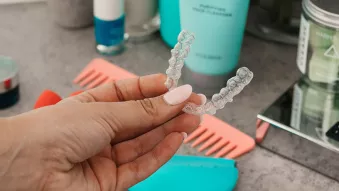How To Find A Clear Aligner Provider In 4 Easy Steps

If you are thinking about getting clear aligners to improve your smile and don’t know how to find a doctor or understand your options, this quick guide is all you need to get started.
First, it’s important to understand that not all aligners are the same and not all doctors use the same aligner and braces' brands.
Second, it’s important to know the role of a trained specialist in your treatment. A doctor’s involvement in your care can make the difference between a great outcome you are satisfied with and one where you are not. Some clear aligners can be ordered by mail and eliminate the role of an orthodontist or dentist in your care.1 We do not recommend that.
The Role Of A Trained Expert — Doctors Who Use Clear Aligners
What type of doctor is best for clear aligner treatment?
Although aligners are not braces, they move teeth incrementally and consistently over time in the same manner as an orthodontist would treat you with conventional braces.2 Both dentists and orthodontists offer aligner therapy to their patients. So, what is the difference between the two you may ask.
A dentist is schooled to treat diseases and conditions that affect the teeth and gums, especially the repair and extraction of teeth and the insertion of artificial teeth.3 An orthodontist is an expert in the movement of teeth and the alignment of jaws.4
Both dentists and orthodontists go to college and then dental school (usually an additional four years). An orthodontist then goes on to get additional training. Similar to a medical specialist, such as an orthopedist or surgeon, orthodontists complete a residency program for two to three years after dental school where they receive intensive instruction in dental, jaw and facial development and proper and safe tooth movement. The extra years of schooling make the orthodontist a dental specialist in moving teeth and aligning jaws. Dental school provides minimal training in orthodontics compared to the thousands of hours of advanced study an orthodontist receives.4
Some orthodontists work with conventional braces, some with more advanced braces systems (like the Damon™ System), some prescribe clear aligners (such as Spark™), and others offer multiple modalities depending upon the patient’s needs. Many patients who have mild or moderate malocclusion (crowding, spacing, overbite, underbite, open bite, deep bite, crossbite, etc.) are good candidates for aligner therapy.5
Tips For Finding A Great Orthodontist / Doctor
Once you’ve determined you’d like to find an orthodontist, here are some tips to help you locate the best clear aligner doctor for you.
- Seek Referrals: Chances are you have friends, family, co-workers or classmates who have been treated by an orthodontist they like and would recommend. Ask your trusted friends and family for recommendations.
- Research your Referrals: Check out recommended orthodontists’ websites and social media accounts, and review any feedback online: Yelp, local Google reviews, etc. On each website, you will find doctor credentials, products and services offered, before and after photos of aligner treatment of your same issues, patient testimonials, and payment and insurance information. On social media, you will likely see a lot of great patient photos and testimonials. You also can see what complaints patients have voiced.
- Use Professional Doctor Finders: If you don’t have any referrals from friends or family, you look at options in your area at the doctor locator of the British Orthodontic Society or the doctor locator for Spark Clear Aligners.
- Obtain a Consultation/Diagnosis from One or More Orthodontists: The best way to find the right doctor and treatment team is to meet and see for yourself. A consult also will enable you to see the doctor’s office, meet the office staff, discuss your insurance benefits, and learn about payment options. A diagnosis from an orthodontist will be important to understand the issues you need to correct and the best treatment options. Meeting with more than one doctor/treatment team should give you a good comparison between two options. Most orthodontists provide complimentary consultations.
There are usually seven main take-aways from an orthodontic consultation:6
- What your orthodontic problem is
- Options to correct the problem
- Customised treatment goals
- Whether teeth will need to be removed
- Whether you will need other services to reach optimal dental health
- An estimate on the length of orthodontic treatment
- The estimated cost of your care (with or without insurance)
Some of the Key Benefits of Clear Aligners
If you are still in the discovery phase and aren’t sure if aligners are right for you. Here are a few of the primary benefits to consider as you make your decision.
- Enjoy the Foods You Love: Aligners are removable, so there are no forbidden foods or beverages. Although aligners should be worn 22 hours a day (except when eating, drinking or brushing), taking them out for meals and snacks means you can eat popcorn, carrots, apples, sticky snacks, red wine, soda and other items off limits to those with braces. The key is to brush after eating and before placing your aligners back in your mouth.
- Easy Hygiene: Because aligners are removable and don’t involve brackets and wires like conventional braces, good hygiene during treatment is easy to maintain.
- Almost Undetectable: Because aligners are made of clear plastic material, they are almost invisible, making wear discreet. Spark Clear Aligners are more clear and stain less than the leading aligner brand.5
- For Adolescents and Adults: There are aligners cleared by the FDA for treatment of children, teens and adults, not just adults, including Spark Clear Aligners.5
- Fewer Office Visits: Clear aligners may require fewer office visits than conventional braces because there are no wires to replace or brackets to tighten. Visits are just to ensure treatment is progressing as planned and to pick up your next few sets of aligners.
If you decide clear aligners are right for your orthodontic treatment, follow your doctor’s treatment plan and rules of wear to achieve the best outcome on schedule. Your doctor-patient relationship should be treated like a partnership, with good communications and you living up to your end of the partnership.



